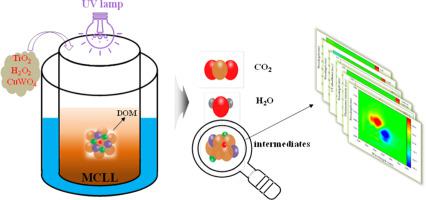Journal of Water Process Engineering ( IF 7 ) Pub Date : 2021-07-20 , DOI: 10.1016/j.jwpe.2021.102220 Chunying Teng 1 , Kanggen Zhou 1 , Weihan Yang 1 , Xuekai Zhang 1 , Changhong Peng 1 , Wei Chen 1

|
Membrane concentrated landfill leachate (MCLL) is a complex wastewater with high amounts of recalcitrant organic pollutants. TiO2-based photocatalysis is a promising technique to treat recalcitrant organic pollutants, but the low quantum efficiency limits its application. In this work, an enhanced photocatalysis approach was proposed to treat MCLL based on the synergistic effects of TiO2, CuWO4 and H2O2, through which 90.56 ± 1.1% COD and 71.83 ± 1.3% TOC can be removed, and the degradation process followed pseudo first-order kinetics. The structural changes of MCLL were examined by spectroscopic techniques. UV–Vis spectral results indicate the effective removal of chromophores in MCLL with decreases in molecular weight, aromaticity and C C/C
C/C O content. Fluorescence excitation-emission matrix coupled with parallel factor analysis was used to characterize the changes of fluorescent substances during the enhanced photocatalysis process. Two fluorescent components, i.e., humic-like and fulvic-like components, were identified, both of which were effectively removed. Two-dimensional correlation spectroscopy suggested the degradation of substances in MCLL in the order: humic-like > fulvic-like components & unsaturated conjugate structure > the aromatic structure containing benzene ring. This work provides a deep understanding of structural changes of MCLL and offers a guidance for the treatment of MCLL through enhanced photocatalysis by H2O2 + TiO2 + CuWO4 synergism.
O content. Fluorescence excitation-emission matrix coupled with parallel factor analysis was used to characterize the changes of fluorescent substances during the enhanced photocatalysis process. Two fluorescent components, i.e., humic-like and fulvic-like components, were identified, both of which were effectively removed. Two-dimensional correlation spectroscopy suggested the degradation of substances in MCLL in the order: humic-like > fulvic-like components & unsaturated conjugate structure > the aromatic structure containing benzene ring. This work provides a deep understanding of structural changes of MCLL and offers a guidance for the treatment of MCLL through enhanced photocatalysis by H2O2 + TiO2 + CuWO4 synergism.
中文翻译:

使用光谱方法揭示膜浓缩垃圾填埋渗滤液在增强光催化过程中的降解
膜浓缩垃圾填埋渗滤液 (MCLL) 是一种复杂的废水,含有大量顽固性有机污染物。TiO 2基光催化是一种很有前途的处理顽固有机污染物的技术,但量子效率低限制了其应用。在这项工作中,基于 TiO 2、CuWO 4和 H 2 O 2的协同作用,提出了一种增强的光催化方法来处理 MCLL。,通过它可以去除 90.56 ± 1.1% COD 和 71.83 ± 1.3% TOC,并且降解过程遵循伪一级动力学。MCLL 的结构变化通过光谱技术检查。UV-Vis 光谱结果表明 MCLL 中的发色团有效去除,分子量、芳香性和 C  C/C 降低
C/C 降低 哦内容。采用荧光激发-发射矩阵结合平行因子分析表征增强光催化过程中荧光物质的变化。鉴定出两种荧光成分,即类腐殖质和类黄腐霉成分,均被有效去除。二维相关光谱表明MCLL中物质的降解顺序为:类腐殖质>类富里酸成分&不饱和共轭结构>含苯环的芳香结构。这项工作深入了解了MCLL的结构变化,并为通过H 2 O 2 + TiO 2 + CuWO 4协同作用增强光催化来治疗MCLL提供了指导。
哦内容。采用荧光激发-发射矩阵结合平行因子分析表征增强光催化过程中荧光物质的变化。鉴定出两种荧光成分,即类腐殖质和类黄腐霉成分,均被有效去除。二维相关光谱表明MCLL中物质的降解顺序为:类腐殖质>类富里酸成分&不饱和共轭结构>含苯环的芳香结构。这项工作深入了解了MCLL的结构变化,并为通过H 2 O 2 + TiO 2 + CuWO 4协同作用增强光催化来治疗MCLL提供了指导。


























 京公网安备 11010802027423号
京公网安备 11010802027423号